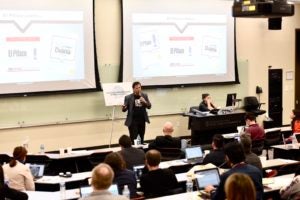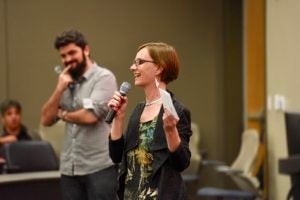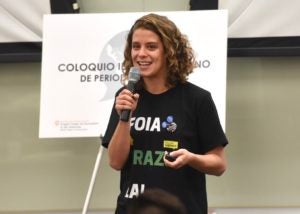April 19, 2019 | Coloquio, Innovation
Latin American news sites share innovations to overcome censorship and lack of funding
A “lightning round” focused on innovative projects ended the 12th Ibero-American Colloquium of Digital Journalism on April 14, an event held the day after the close of the International Symposium on Online Journalism (ISOJ).

Through short five-minute presentations, media representatives from Argentina, Brazil, Guatemala, Uruguay and Venezuela told the audience how their sites try to face common challenges related to financing, obtaining information or attracting a loyal audience, all while aiming to make quality journalism.
One of the news sites with great local and national coverage of Venezuela started the presentations, El Pitazo. Its director, César Batiz, used a video to show a summary of the challenges and obstacles that they must circumvent daily as a media outlet.
Given this situation, the multiplatform media El Pitazo has trained 1,076 “info-citizens” so far, which, according to Batiz, are citizens correspondents who they count on to cover the news in each region of the country.
In order to overcome the censorship to which they are constantly subjected, and after suffering blockings of their web domains, they have created a mobile application with the name of their site. Through this they have found another way to inform about what happens in Venezuela.
They also consider it very important to make editorial alliances with other media to seek more financing and also work collaboratively.
Due to the challenges that journalism always faces in terms of financing sources, the news site Nómada, of Guatemala, has found the possibility of financing about a quarter of its expenses through the sale of design products. “Investing in design is profitable,” said Lucía Menéndez, editor of the site’s art and design.
“Design not only has an impact on journalism but (makes it so that) journalism can also produce money,” Menéndez said. Nueve, Nómada’s content agency, was born from this bet on design and has developed around 30 products to date.
Regarding Argentina, digital media Chequeado and Infobae also shared their experiences.
Chequeado, launched in 2010 and the first digital site for verification of public discourse in Latin America, aims to continue expanding.

According to its director of editorial innovation Pablo Fernández and project coordinator Olivia Sohr, what they are looking for is to shape a network of checkers in Latin America that through meetings could exchange and share checking techniques and new formats of storytelling. Both in relation to public discourse and the misinformation that circulates in social networks, the so-called “fake news”.
They have organized three meetings so far in Argentina and invited colleagues from other countries present at the Colloquium to join this initiative.
Regarding Infobae, they bet both on quality journalistic content and on content that is massive and could go viral, said deputy director Leonardo Mindez. “I think it’s the way to survive, today, for us,” he said.
“We bet on the quality stories to tell the current events, and the old stories (…) that were forgotten, and they are the ones that give us the most traffic. We are very attentive to the metrics, the social network team works hand-in-hand with the newsroom, (…) to know what interests people at that moment,” Mindez said. Infobae had 58 million unique visitors in March, making it the second most important media outlet in Spanish in the world, he added.
Regarding Brazil, two women presented media cases that, although with a different approach, share the same objective: to empower the community through information.
Izabela Moi shared her experience with Mural, a journalism agency in the peripheries of which she is co-founder and co-executive director. Mural, which was born as a blog of the newspaper Folha de S. Paulo in 2010, grew in participants and impact so that in 2015 it became a site of its own, and in 2018 it was registered as a non-profit organization.
Moi explained that in 2010 she noticed those “news deserts” in the peripheries of Greater São Paulo, an area that includes 39 cities and 21 million people. They only appeared in the news when “bad things” such as murder or robbery happened.
With the voluntary work of 189 young reporters from the peripheries – known as “muralistas” – the site has counted more than 2,500 stories. Currently, it has alliances to transmit its content with Folha, Carta Capital, CBN and Global Voices, among others.
“Mural has the same principle as the Mexican mural: with the people and for the people,” Moi said.
For Maria Vitória Ramos, information is also key. That is why she knows that her job as financial director and reporter of the site Fiquem Sabendo, founded in 2015, is “to create an informed society and to be a social control of the government”.
Ramos explained that one of the most recent projects of the site specialized in making reports based on data obtained through the Access to Information Law (LAI) of the country, wants to reveal more than 70,000 documents that “the government does not publish although they are no longer confidential.”
Ramos announced that they made an alliance with the organization Muckrock that shared all its technology and documents.

Fiquem Sabendo of Brazil (Erika Rich/Knight Center)
“Everything we organize is in creative commons. We opened the original database,” Ramos said. “We promote content of social interest”.
The case of la diaria of Uruguay is one that shows how it is possible to maintain a media outlet with the support of the people. According to Damián Osta, co-founder and manager of this newspaper, people began to support a newspaper before it even existed and this group created a cooperative that they call their community.
After years of work that allow it currently to be a media outlet in which 120 people work and with good financial sustainability, Osta is convinced that without that community its existence would not be possible.
“We reinvent ourselves every day. We start from the basis of recognizing that our greatest value is in our community. Ask them when we need them, [so] they could help us to do better journalism,” Osta said. According to him, it is no longer necessary to ask them all the time for money to continue operations.
They are no longer a printed newspaper, so their verticals (now on their digital site) are focused on addressing issues of interest to that community. He explained that they like to feel so close to this, that to celebrate their anniversary they have a party in which journalists and community participate.

